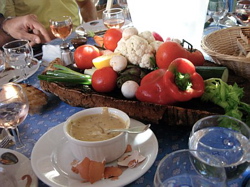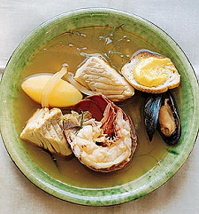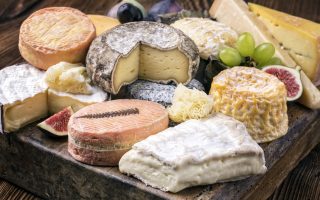Provençal Cuisine


A brief list of terminology
Mother Nature is abundantly generous in this part of the world, and Provençal cooking is naturally tasty and flavorsome due to the sun-kissed produce that is readily available in this region. Vegetables, sardines, anchovies, meat casseroles, ratatouille and pesto. Not to mention the aromatic herbs which grow plentifully here – thyme, rosemary, savory, basil, and others – all of which are widely used in Provençal cuisine. And of course there are the biggest stars of all – garlic and olive oil! As with any region, Provence has its own unique recipes and dishes. There are far too many to include on this page, but here are a few specialty dishes that are typical of the region and an important part of any Provençal cuisine:
Aïoii is the accent of Provençal cuisine. It is a mayonnaise made with olive oil and generously seasoned with crushed garlic. It is an accompaniment to vegetables and fish.
Anchöiade is an anchovy and garlic purée typical to the south of France. It is usually served on toast or with raw vegetables, known as crudités. The recipe varies from region to region, and from family to family.

Bouillabaisse
Bouillabaisse is a renowned Marseilles fish soup whose special taste is made from a mixture of Mediterranean fish: scorpion fish, mullet, monkfish, conger eel, spider crab and. It is usually served with a traditional spicy sauce, known as rouille.
Catigau is a fricassée (a dish consisting of fish or meat cut into pieces and cooked in gravy) made from grilled or smoked eels fished directly from the Rhône River.
Loup is the Mediterranean name for sea bass, and is delicious grilled over a barbecue or in the oven. It can be stuffed with fresh fennel or simply prepared with olive oil and a sprinkle of fresh herbs de Provence.
Pistou is a basil, garlic and olive oil condiment. It is similar to the Italian pesto, but is made without the pine nuts. The basil leaves are crushed or pounded with a mortar and pestle (or a food processor in most cases these days) before being added to the olive oil. The word itself is derived from the Provençal word ‘pestare’ which means to pound. Many claim the only way to retain the bright green color from the basil is by pounding it the old way, with a mortar and pestle.
Ratatouille is a delicious vegetable stew composed of peppers, courgettes (zucchini), aubergines (eggplant), tomatoes and onions, all prepared with olive oil. Eaten cold as a starter or hot as an accompaniment to fish or meat, ratatouille is an excellent addition to any Provençal meal.
.jpg)
Tapenade
Rouille is a type of mayonnaise sauce that consists of either olive oil with bread, or breadcrumbs with spices (in which case it iss usually highly spiced with chile peppers). It is usually served with fish and fish soup dishes. The actual name comes from the French word for rust, hence the color of the sauce.
Sisteron lamb are fed on wild thyme and rosemary, which is what makes this dish so tasty. Not every palate can distinguish the difference, though a delicate palate will certainly be able to pick up on these aromas once the meat is served.
Tapenade is a purée of olives crushed with a mortar and pestle and mixed with garlic, capers and anchovies. It can be eaten simply with a slice of grilled bread, or served as an accompaniment to fish or meat.
Share to: Facebook Twitter LinkedIn Email
More in cooking, courses, family, fishing, food, provence, river
By FrenchEntrée
Leave a reply
Your email address will not be published. Required fields are marked *



